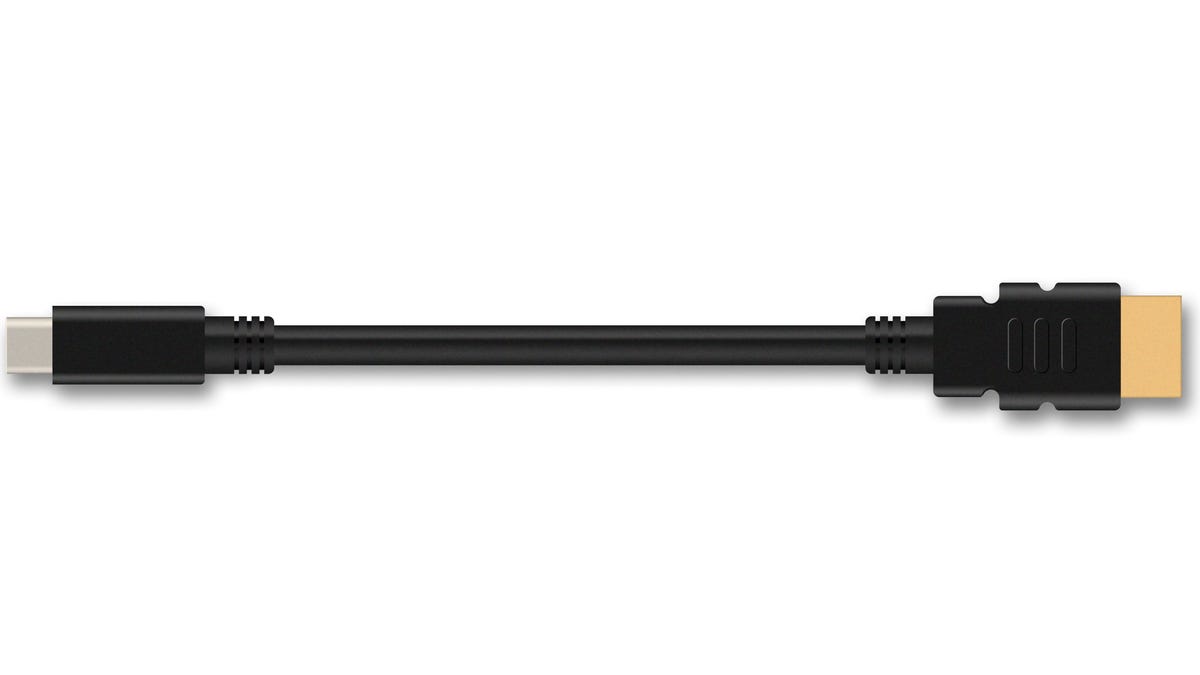 Why You Can Trust CNET
Why You Can Trust CNET USB-C could doom your laptop's trusty video port
The slim, new USB-C port already can shoulder the duties of power and audio ports. Starting in 2017 it could squeeze HDMI off computers, too.

Still shocked by Apple killing off the headphone jack in the iPhone 7? The beloved HDMI port on your laptop and TV may be next on the chopping block.
That's because starting in 2017, the new USB Type-C will have the ability to work like an HDMI port, which up to now has been the lifeline for getting what's displayed on your laptop over to a TV.
One cheap cable between the PC and the TV will do the trick.
USB is already a smashing success with billions of connectors on everything from car dashboards to electrically heated fingerless gloves. USB-C, though, holds the potential to move to the next level, exterminating ports that do only one job. Those include the DisplayPort for video, the 3.5mm audio jack, the power plug -- and now HDMI.
Apple added HDMI connectors to its MacBook Pro in 2012, but USB-C could allow the company to zap them. So if you have a sentimental attachment to HDMI, better take some snapshots now for your photo album.
And if you've got a lot of TVs, chargers, external drives and other doodads from the pre-USB-C era, prepare for some transitional hassles. Even though PCs won't immediately drop the traditional USB Type-A ports that have been a fixture for 20 years, you'll need new adapters and dongles to get by. Such is the price of progress.
The full transition to USB-C will take years, but IHS analyst Brian O'Rourke expects it will indeed happen. USB already is multipurpose, but USB-C goes further with a feature called alt mode that makes it a "do-everything connector," he said.
If you're fretting over the end of the HDMI port, historical perspective might lower your blood pressure. The computing industry has a long history of abandoning ports to move to faster, smaller, more capable technology. And the short-term pain is usually worth it.
The 15-pin VGA connector was invented in 1987 and enjoyed a two-decade run until HDMI pushed it aside. Firewire doomed SCSI for connecting external hard drives on Macs, then USB speed improvements doomed Firewire. Wireless technology let us drop the Ethernet port and now routinely cuts cords for earphones, keyboards, printers and mice.
PC makers on board
Moving HDMI to USB-C makes sense, said Luis Hernandez, a vice president in Lenovo's PC and Smart Device Business Group. USB-C will make devices easier to use by simplifying cable options, making devices thinner, and unifying the port used on phones, tablets and PCs. (Well, except for iPhones and iPads that use Apple's own Lightning port, but Apple has embraced USB-C on Macs.)
A single cable will connect a PC's USB-C port to a TV's HDMI port for sending video and audio data.
Mike Nash, HP's vice president of customer experience, likes USB-C for the design possibilities it opens up. The company's Spectre PC has a body 8 millimeters thick, which simply isn't enough for traditional barrel-shaped power plugs or the older Type-A USB ports.
HDMI ports are even thicker, he said.
Consumer electronics devices such as TVs, stereos and set-top boxes have come with USB ports for years, but they've played second fiddle to HDMI. USB-C's ability to carry both video and audio data could encourage consumer electronics players to give the port a starring role.
Members of the HDMI Founders trade group demonstrated prototype HDMI over USB-C in September. Expect products to show up at January's Consumer Electronics Show.
Consumer confusion
There's no guarantee, however, that each USB-C port will have all possible abilities.
For instance, USB-C supports the older HDMI 1.4b specification, including high-resolution 4K video, surround sound audio, 3D video encryption for copy protection and Ethernet network data. But it doesn't support the newer 2.0b standard, which adds high-dynamic range video, 32-channel audio and 60-frame-per-second 4K video.
The HDMI Forum, which governs HDMI 2.0b, hasn't announced its plans for USB-C support.
The USB Implementers Forum suggests a variety of logos to dispel confusion -- SS for super-speed transfer rates, DP for DisplayPort video, batteries for power delivery. And HDMI backers hope device makers will likewise include the HDMI logo when it's supported, too. Even if consumers learn to decode the logos, USB-C connectors are too small to accommodate every logo.
"The biggest problem for USB Type-C with consumers is likely to be a marketing one," O'Rourke said. "How do you communicate the capabilities of a single Type-C port?"
Confusion over USB-C abilities already was a problem before the HDMI option arrived.
Now more confusion is possible with Intel's Thunderbolt port, a higher-speed connection technology that also has just begun using the USB-C connector. Thunderbolt's lightning-bolt logo on port ensures you'll get everything great about USB-C, except HDMI.
So USB-C isn't perfect and could temporarily mean taking a step back. But in the long run, new technology usually takes two steps forward too.

